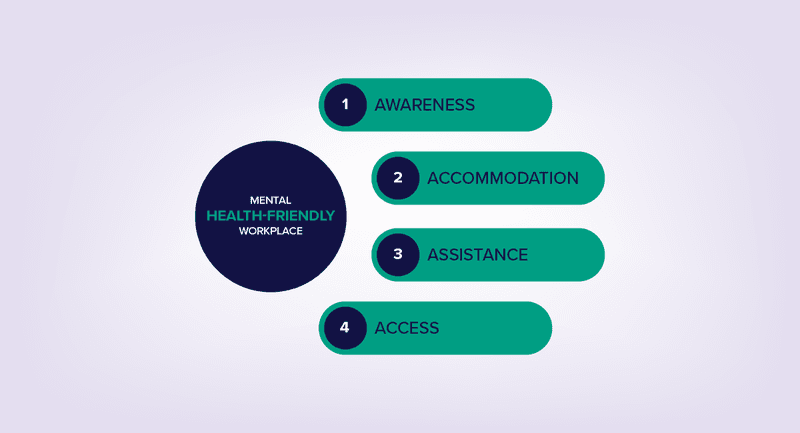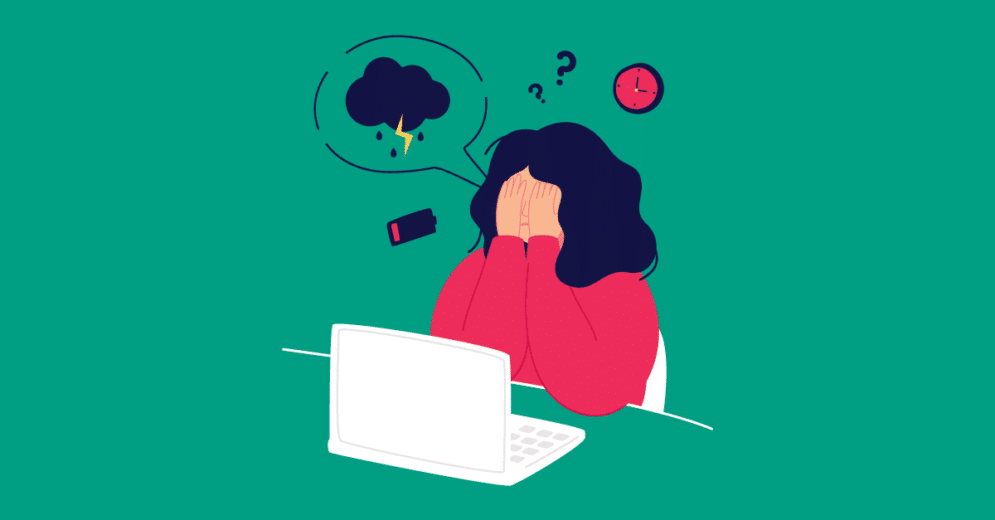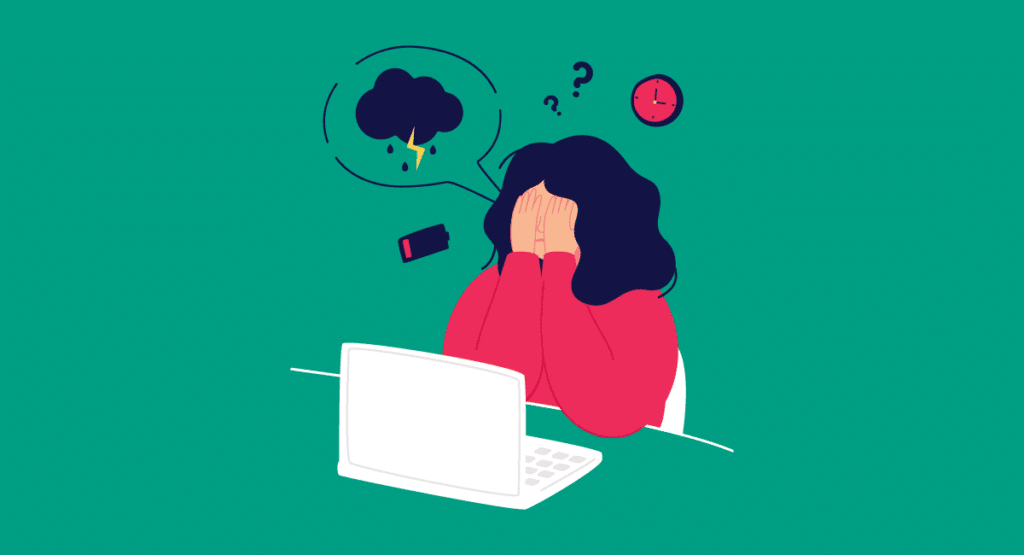Have you ever heard of Burnout Syndrome? Also known as Professional Exhaustion Syndrome, burnout was one of the most searched terms on Google during the pandemic.
This syndrome is now recognized by the WHO (World Health Organization) as “chronic work stress that has not been successfully managed“.
It’s important to point out that burnout is not only a work-related problem, it also affects your personal life. Pay attention to the signs and learn how to prevent this kind of exhaustion that affects the lives of so many people.
What is Burnout?
Burnout Syndrome is the manifestation of chronic unmanaged stress.
Thus, burnout is characterized by a state of physical, emotional, and mental exhaustion caused by prolonged stress. It’s usually also linked to a feeling of disillusionment with one’s job or profession.
Another factor contributing to Burnout Syndrome is the changes in our relationship with work, which is increasingly mixed with our personal lives.
We work from home, have more interpersonal relationships (it is even required as an indispensable soft skill in many areas), and are constantly connected to work.
In addition, we have jobs that demand much more from our minds than from our bodies.
And this mental fatigue can be extremely harmful to your health. If your professional life is not going well, it will consequently affect other areas of your life.
Even the psychoanalyst Christophe Dejours, creator of the psychodynamics of work, states that:
The relationship with work is always present, both in the construction of mental health and in the genesis of illness. Or, to put it another way, the relationship with work is never neutral with regard to mental health.
Therefore, it’s necessary to pay more attention to the social and organizational environment in which individuals work, and not only to what each person must do to avoid burnout.
How to identify the symptoms of this syndrome?

When a person is under stress, the body responds to it, and one of these responses is the release of hormones such as cortisol and adrenaline at higher levels than normal.
While this response is useful in the short term to help us cope with challenges, if it happens on a prolonged basis, it can damage our physical and mental health.
In fact, one of the most common symptoms of burnout is insomnia. When researchers in Italy interviewed healthcare professionals with burnout during the pandemic, they found that 55% reported difficulty getting to sleep, while almost 40% had nightmares.
This is because chronic stress interferes with the neurological and hormonal system that regulates sleep. It’s a vicious cycle because not sleeping puts our system even more out of sync.
So if you notice that you’re having trouble sleeping at night, it could be a sign that you’re under stress – and this insomnia could further exacerbate the problem.
Look out for the most common signs of Burnout
Physical symptoms include extreme fatigue, trouble falling asleep, changes in appetite, headaches, stomach aches, or muscle aches.
When it comes to emotional symptoms, there is usually a lack of motivation, difficulty making decisions, feelings of loneliness, or general dissatisfaction.
Behavioral symptoms can include social isolation, difficulty handling responsibilities, and work-related outbursts of anger.
Here is a general list of symptoms related to chronic stress:
- Physical exhaustion: chronic fatigue and tiredness, even after a good night’s sleep.
- Emotional detachment: the feeling of distance or emotional numbness from work, co-workers, and even activities that used to bring joy.
- Reduced effectiveness and efficiency: decreased job performance and difficulty completing tasks, even those that were once routine.
- Negative attitudes toward work: increased cynicism and frustration about the job or workplace.
- Mental and emotional distress: symptoms such as anxiety, depression, irritability, and insomnia.
- Decreased sense of accomplishment: feeling that you are not making progress or reaching goals, even though you work hard.
- Reduced self-esteem: feeling that you are not competent or valued at work.
It’s important to pay attention to these symptoms and seek help if they persist over a long period of time.
A mental health professional can help diagnose the syndrome and develop a treatment plan!
Reading Tip: Remote Work: What is the Outlook During and After the Pandemic?
What causes the Burnout Syndrome?
The exact cause of burnout is not well understood, but it is believed to be the result of a combination of factors, including work-related stress, lack of control and autonomy, and lack of work-life balance.
People who work in high-stress situations or demands are particularly vulnerable to burnout – including in the UX and Product Design professions, as we’ll see below.
If you are already experiencing symptoms of stress or insomnia, it’s important to seek help and other ways to alleviate these signs.
Remember that symptoms tend to worsen over time if left untreated, and burnout is just that: untreated or unmanaged stress.
Prevention is better than cure
Some lifestyle choices can make burnout less likely. Social support, for example, can help. This can include talking to a therapist or meeting with friends.
You can also take advantage of mental health or exercise benefits offered by your employer.
And as mentioned earlier, and it’s important to pound on this, getting more and better sleep can help.
How to Avoid the Burnout Syndrome

There are several strategies that can help you avoid chronic stress, check out a few:
- Prioritize your well-being: make sure to engage in activities that bring you joy and help you relax, such as exercise, meditation, reading, or spending time with friends and family.
- Maintain a healthy work-life balance: Make sure you set boundaries between work and personal time and avoid overloading yourself with work.
- Manage stress: Identify the sources of stress in your life and develop coping strategies such as time management, stress reduction activities, or seeking support from a therapist.
- Build a support network: Surround yourself with positive, supportive people you can rely on in times of stress.
- Take breaks: Taking regular time off from work can help you recharge your energy and avoid burnout.
- Find meaning and purpose in your work: Try to connect with the higher purpose of your work and find ways to make it personally rewarding.
- Seek support: if you are experiencing symptoms of burnout, don’t hesitate to seek help from a mental health professional.
By incorporating these strategies into your life, you can reduce the risk of burnout and maintain your physical, mental, and emotional well-being.
Reading Tip: 5 Soft Skills to Make a Difference as a Designer
Treating Symptoms

Don’t ignore the symptoms, hoping that the situation will resolve itself over time. It’s very common for us to ignore our own problems, especially in our culture where we are taught to “work hard” and where there is so much comparison with the success of others.
Treatment for burnout is done with psychotherapy, but it can also involve medication (antidepressants or anxiolytics).
So seek professional help and ask your family and friends for support. The best solution is to address the root of the problem.
Burnout is usually recognized when it is caused by work, but chronic stress can have many causes – financial problems, relationship problems, and overload with care (children or relatives), among other things.
Think about the thorns in your side that you have to deal with and think of ways to remove some of them. Perhaps you can ask for help with your children’s bedtime routine or order food by delivery so you don’t have to plan dinner as well.
Therapy and counseling can be helpful in addressing other burnout-related causes and developing coping strategies.
With the right support, it’s possible to recover from burnout and regain a sense of balance and well-being.
Controversies
According to Dr. Maslach in a New York Times article, despite the popular coverage of the problem, the treatment of burnout should not be attributed to the individual’s responsiveness.
According to him, this would only make the situation worse, as we would be placing the responsibility on the burned-out person and suggesting that they should do more to feel better. Which, according to the doctor, should not be treated this way.
After all, who’s to blame?

It is common to think of burnout as an individual problem that should be solved with wellness practices.
This can help reduce individual stress, but the main factors that cause employee burnout have little to do with an individual, but rather how they are managed.
Company culture, ways of working, and organizational structure are set and controlled by organizations, which in turn impact employee well-being.
It’s important to understand that things like workload, “favorite” employees, lack of flexibility, poor or non-assertive communication, incompatible values, lack of a sense of community, lack of workplace autonomy, or failure to provide adequate resources will sooner or later result in chronic stress situations.
According to a survey conducted by Gallup, the top 5 reasons for burnout are:
- Unfair treatment at work
- Unmanageable workload
- Lack of clarity about the role
- Lack of communication and support from the manager or leader
- Unreasonable time pressure
All five of these factors are significantly influenced by the behavior of a company’s leaders and managers.
Managers have a responsibility to protect employees from unfair treatment in the workplace, to communicate clearly, and to provide support.
In addition, managers should be advocates and allies for their team members when it comes to setting priorities, managing workload, and establishing reasonable expectations of others.
Organizations must hold themselves accountable
As mentioned earlier, companies can and should view high burnout rates as a warning sign that organizations need to undergo significant change.
Employers must take a systems approach.
The systems approach means addressing toxic behavior in the workplace and redesigning work to be inclusive, sustainable, and supportive of individual learning and growth, including the leader and employee adaptability skills.
According to McKinsey, organizations that deal with toxic behavior effectively implement a set of integrated work practices to address the problem.
In these companies, toxic behavior is flagged, those responsible for such behavior change or leave the company, and leaders become aware of the impact their behavior has on others.
If you hold a leadership role, observing your own behaviors and what you allow to happen in your own management is a good starting point.
How to implement a mental health program

EARN and others promoting mental health at work have come up with 4 key elements for mental health programs in organizations:
- Awareness and education
- Welcoming and listening
- Referrals and coaching
- Adaptation and conciliation
Listed below are some actions your organization can take to promote these 4 elements:
- Apply burnout, workaholism, and wellness risk assessments in the workplace;
- Mental health awareness events and campaigns
- Facilitate listening encounters;
- Training in psychological safety and nonviolent communication and compassionate leadership;
- Mental health first aid;
- Contract mental health services for the treatment of individuals in crisis;
- Train peers and managers to reintegrate a departing employee, taking into account his or her needs and constraints
- Re-evaluation of the scope of work, sizing up the current delivery capabilities, and involvement of the employee in adaptation reconciling with the organization’s needs.
The connection between suicide and Burnout syndrome
A síndrome de Burnout é reconhecidamente um fator de risco para a depressão e o suicídio.
Burnout syndrome is known to be a risk factor for depression and suicide.
In one of the Burnout Anonymous support group meetings, one of the participants mentioned having had suicidal thoughts. After her account, the other participants were asked to raise their hands if they had ever had such thoughts of ending their own life during their burnout. All of them raised their hands.
Brazil is the country with the second highest number of burnout cases in the survey conducted by ISMA (International Stress Management Association), ahead even of the United States.
According to the WHO (World Health Organization), Brazil is also the country with the highest rate of people suffering from anxiety and the fifth in cases of depression.
Reading Tip: The Importance of Psychology in UX Design
Burnout and UX Design
Burnout can be a particular concern for people in the UX or Product Design field.
These fields require high levels of creativity, problem-solving, and attention to detail, which can be mentally and emotionally challenging.
In addition, the fast pace of technological change and the pressure to deliver results can also contribute to stress and burnout.
Therefore, to avoid burnout in UX professions, it’s important to take steps to manage stress and maintain a healthy work-life balance.
It is imperative that organizations recognize the importance of mental health and provide support for employees, such as flexible work schedules, professional development opportunities, and access to mental health resources – in addition to the other factors mentioned previously.








